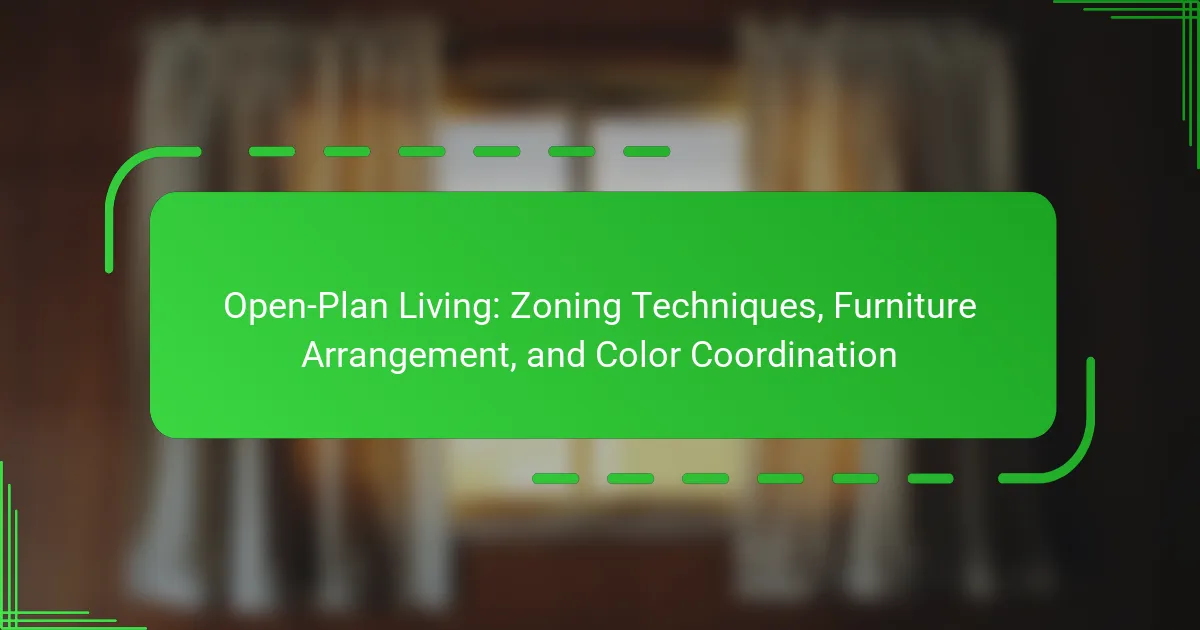Open-plan living is a contemporary design concept that integrates multiple functional areas, such as the living room, dining area, and kitchen, into a spacious environment. This layout enhances social interaction, increases natural light flow, and can improve family dynamics while appealing to modern buyers. The article explores effective strategies for achieving open-plan living, including zoning techniques to define activity areas, smart furniture arrangement to promote conversation, and cohesive color coordination to create visual harmony. Research highlights the impact of color on mood and productivity, emphasizing the importance of strategic choices in enhancing both aesthetics and functionality in open-plan spaces.

What is Open-Plan Living?
Open-plan living is a design concept that combines multiple functional areas into a single, large space. This layout typically merges the living room, dining area, and kitchen. The goal is to create an open and airy environment. Open-plan living fosters social interaction and allows for flexible use of space. It often enhances natural light flow throughout the area. This design has gained popularity in modern homes due to its versatility. Research indicates that open-plan layouts can improve family dynamics by encouraging togetherness. Studies show that such designs can increase property value by appealing to contemporary buyers.
How does Open-Plan Living differ from traditional layouts?
Open-plan living features a large, unobstructed space combining multiple functions, unlike traditional layouts that separate rooms. The absence of walls in open-plan designs promotes a sense of spaciousness and connectivity. This layout encourages social interaction and easier movement between areas. Traditional layouts often compartmentalize spaces, which can restrict flow and communication. Open-plan living also allows for more flexible furniture arrangements. In contrast, traditional layouts typically adhere to fixed room purposes. Studies show that open-plan spaces can enhance natural light and ventilation, improving overall ambiance.
What are the key characteristics of Open-Plan Living?
Open-plan living is characterized by a large, unobstructed space that combines multiple functional areas. This layout promotes a sense of openness and connectivity among different spaces, such as the living room, dining area, and kitchen. Natural light is often maximized through large windows and minimal interior walls. Flexibility in furniture arrangement is a key feature, allowing for versatile use of the space. Zoning techniques, such as area rugs or furniture placement, help define different functional areas within the open space. Additionally, cohesive color schemes are commonly utilized to create a harmonious flow throughout the area. Open-plan living is popular in modern home design, reflecting contemporary lifestyle preferences for social interaction and ease of movement.
Why is Open-Plan Living gaining popularity in modern homes?
Open-plan living is gaining popularity in modern homes due to its spacious and flexible design. This layout encourages social interaction and a sense of community among family members. It allows for better natural light flow throughout the space. Open-plan designs can make smaller homes feel larger and more inviting. They also offer versatile furniture arrangement options. Homeowners appreciate the ease of entertaining in an open space. Additionally, this design trend aligns with contemporary lifestyle preferences for minimalism and functionality. According to a study by the National Association of Home Builders, 84% of homebuyers prefer open-concept layouts for their homes.
What are the main zoning techniques in Open-Plan Living?
The main zoning techniques in open-plan living include furniture arrangement, area rugs, and lighting. Furniture arrangement involves placing furniture to create distinct functional areas. For example, a sofa can define a living space while a dining table marks the dining area. Area rugs serve as visual boundaries, helping to separate spaces without physical barriers. Lighting can also delineate zones; different light fixtures can indicate various functions. These techniques enhance organization and flow in open-plan layouts.
How can zoning enhance functionality in an open space?
Zoning enhances functionality in an open space by defining areas for specific activities. This organization improves flow and usability. For example, zoning can separate living, dining, and work areas. Each zone can be tailored to its purpose, increasing efficiency. Studies show that well-defined spaces can reduce distractions and improve focus. When areas are clearly marked, users can easily navigate the space. Effective zoning also promotes better social interactions by creating inviting gathering spots. Overall, zoning maximizes the potential of open spaces.
What types of zoning techniques are commonly used?
Commonly used zoning techniques include physical barriers, furniture arrangement, and color coding. Physical barriers like walls or screens create distinct areas within open spaces. Furniture arrangement involves strategically placing items to delineate different functions, such as seating areas or dining spaces. Color coding uses different paint or decor to visually separate zones. These techniques enhance functionality and aesthetics in open-plan living environments. Studies show that effective zoning can improve spatial perception and usability in homes.
What role does furniture arrangement play in Open-Plan Living?
Furniture arrangement in open-plan living is crucial for defining spaces and enhancing functionality. It influences flow and movement within the area. Proper arrangement can create distinct zones for various activities, such as living, dining, and working. For example, using rugs or furniture placement can visually separate these zones. This method fosters social interaction while maintaining privacy. Studies show that well-arranged furniture can improve communication and engagement among occupants. Additionally, thoughtful arrangement maximizes natural light and optimizes space utilization. Thus, furniture arrangement plays a vital role in the overall effectiveness of open-plan living.
How can furniture arrangement optimize space in an open layout?
Furniture arrangement can optimize space in an open layout by defining areas for specific activities. Proper placement of furniture creates visual boundaries, helping to segment the space. For example, positioning a sofa can delineate the living area from dining space. Using multi-functional furniture maximizes utility while minimizing clutter. Items like ottomans or coffee tables with storage can be beneficial. Arranging furniture to facilitate flow enhances movement throughout the area. This can prevent overcrowding and promote a more open feel. Studies show that effective furniture layout can improve the perceived size of a space. In a well-arranged open layout, users report increased comfort and functionality.
What are the best practices for arranging furniture in an open-plan space?
The best practices for arranging furniture in an open-plan space include creating distinct zones for different activities. Use rugs to define areas, such as a living area or dining space. Position larger furniture pieces, like sofas, to face each other to encourage conversation. Ensure there is a clear flow of movement between zones. Use multifunctional furniture to maximize space efficiency. Keep pathways clear to enhance accessibility. Incorporate vertical elements, like shelves or plants, to add dimension. Finally, maintain a cohesive color palette to unify the space visually. These strategies enhance functionality and aesthetics in open-plan living.

How can color coordination improve Open-Plan Living?
Color coordination enhances open-plan living by creating a cohesive visual flow. It helps define distinct areas within a shared space. Different colors can signify various functions, such as relaxation or dining. Harmonious color palettes promote a sense of unity and comfort. Research indicates that well-coordinated colors can positively affect mood and well-being. For instance, a study by the University of Texas found that color influences emotions and can enhance productivity. Therefore, strategic color choices in open-plan layouts can improve both aesthetics and functionality.
What are the principles of color coordination in open spaces?
The principles of color coordination in open spaces include harmony, contrast, balance, and context. Harmony involves selecting colors that complement each other. This creates a unified look throughout the space. Contrast adds visual interest by using differing colors effectively. Balance ensures that no single color overwhelms the space. Context considers the function and mood of the area. For example, warm colors can create an inviting atmosphere. Cool colors may promote calmness. The use of color can also define zones within the open space. Research indicates that color affects mood and perception, supporting these principles.
How do colors affect the perception of space in Open-Plan Living?
Colors significantly influence the perception of space in open-plan living. Light colors, such as whites and pastels, create an airy and expansive feel. Dark colors can make a space feel smaller and more enclosed. The use of color can visually define different areas within an open layout. For instance, a bold accent wall can delineate a living area from a dining space. Additionally, warm colors can create a cozy atmosphere, while cool colors promote calmness and spaciousness. Research indicates that color psychology plays a crucial role in how individuals perceive their environment. A study by the University of British Columbia found that lighter shades enhance perceived space.
What color schemes work best for Open-Plan Living areas?
Neutral color schemes work best for open-plan living areas. Shades like beige, gray, and white create a cohesive look. These colors enhance natural light and make spaces feel larger. Complementary accent colors can be added for visual interest. Soft pastels also work well, providing a calming atmosphere. Darker hues can be used in smaller sections to add depth. According to a study by the American Society of Interior Designers, neutral palettes are preferred for their versatility and timeless appeal.
How does lighting influence color coordination in Open-Plan Living?
Lighting significantly influences color coordination in open-plan living spaces. Different lighting types, such as natural light, warm artificial light, and cool artificial light, can alter how colors appear. Natural light enhances the vibrancy of colors, making them appear more saturated. Warm artificial light can create a cozy atmosphere, softening colors and making them feel inviting. Conversely, cool artificial light can make colors appear sharper and more defined.
The choice of lighting affects how colors interact within the space. For example, a bright, white light can clash with warm tones, while soft lighting can harmonize cooler shades. Additionally, the direction of light impacts shadows and highlights, affecting the perception of color depth. Proper lighting design is essential for achieving cohesive color coordination in open-plan living.
What types of lighting are ideal for enhancing color in open spaces?
Natural lighting and full-spectrum LED lighting are ideal for enhancing color in open spaces. Natural light brings out the true colors of walls and furnishings. It creates a vibrant atmosphere that changes throughout the day. Full-spectrum LED lights mimic natural sunlight. They provide a balanced color temperature that enhances color perception. Studies show that full-spectrum lighting improves visual clarity and color accuracy. This makes spaces feel more inviting and visually appealing. Using a combination of both can maximize color enhancement in open areas.
How can natural light be maximized in an open-plan layout?
Maximizing natural light in an open-plan layout can be achieved through strategic design choices. Use large windows to increase sunlight exposure. Skylights can also enhance light [censured]. Light-colored walls and ceilings reflect more sunlight, brightening the space. Mirrors placed strategically can redirect light throughout the area. Avoid heavy drapes; opt for sheer curtains that allow light while providing privacy. Open spaces should be designed to minimize obstructions to light flow. Furniture arrangement should prioritize keeping pathways clear of shadows. These techniques create a brighter, more inviting environment, promoting well-being and comfort.

What are the practical tips for achieving effective Open-Plan Living?
To achieve effective open-plan living, utilize zoning techniques, smart furniture arrangement, and cohesive color coordination. Zoning can be accomplished through rugs or furniture placement to define areas for different activities. Arrange furniture to promote conversation and flow, avoiding clutter. Use multifunctional furniture to maximize space efficiency. Choose a cohesive color palette to create a harmonious look throughout the area. Incorporate natural light and plants to enhance the atmosphere. These strategies ensure a functional and aesthetically pleasing open-plan environment.
How can I create distinct zones in an open-plan space?
To create distinct zones in an open-plan space, use furniture arrangement and visual cues. Place furniture pieces like sofas, chairs, and tables to define areas. For example, a sofa can separate the living area from the dining space. Use rugs to visually anchor each zone. Different colors can also signal distinct areas. For instance, a warm color for the living zone and a cool color for the dining zone enhances separation. Additionally, consider using screens or plants as physical barriers. These elements provide both functionality and aesthetic appeal. Research shows that well-defined zones improve space utilization and enhance comfort.
What furniture choices support effective zoning in Open-Plan Living?
Furniture choices that support effective zoning in open-plan living include sectional sofas, area rugs, and multifunctional furniture. Sectional sofas create distinct seating areas and visually separate spaces. Area rugs help define zones by anchoring furniture and adding texture. Multifunctional furniture, such as storage ottomans or folding tables, maximizes space while serving multiple purposes. These choices promote organization and functionality in open layouts. Studies indicate that these elements enhance spatial perception and usability in such environments.
How can I maintain a cohesive color palette throughout the space?
To maintain a cohesive color palette throughout the space, select a limited color scheme. Choose three to five colors that complement each other. Use these colors consistently in furniture, decor, and wall paint. This approach creates a unified look across different zones. Consider the 60-30-10 rule for color distribution. This rule suggests 60% of a dominant color, 30% of a secondary color, and 10% of an accent color. Ensure that the chosen colors reflect the mood you want to create. For proof, studies show that cohesive color schemes enhance visual harmony and improve overall space perception.
Open-plan living is a design concept that merges multiple functional areas, such as the living room, dining area, and kitchen, into a large, unobstructed space. This layout promotes social interaction, enhances natural light flow, and allows for flexible use of space, making it increasingly popular in modern homes. Key aspects of open-plan living include zoning techniques to define distinct areas, strategic furniture arrangement for improved flow and functionality, and cohesive color coordination to enhance visual appeal. The article explores these elements in detail, providing practical tips for achieving an effective open-plan environment.
